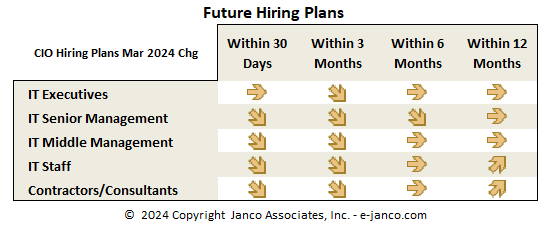No Downturn in Jobs for IT
Despite a cooling economy, tech hiring remains hot. What's more, research suggests it should be sizzling for years to come
Demand for tech talent
No Downturn in Jobs for IT - The U.S. Bureau of Labor Statistics (BLS) list of the 30 fastest growing occupations includes five categories of tech jobs. From 2006 to 2016, the need for network systems and data communications professionals, the position category with greatest demand, is projected to increase by 53.4 percent.
For the same 10-year period, the demand for computer software engineers is projected to increase by 44.6 percent. Twenty-nine percent more computer systems analysts will likewise be needed, as well as 28.6 percent more database administrators. Demand for computer software engineers/systems software engineers will increase by almost as much, 28.2 percent.
(note - Charts have been updated with the latest data. If you want to see the original charts please contact support at e-janco.com. Text is the original text. Specify which charts and dates you desire and they are available for free to paid subscribers of the CIO - IT Manager Newsletter)
Current IT Hiring Plans - IT Job Hiring Stalls
With the move towards Artificial Intelligence, the treat of an economic downturn, inflation, high energy cost, and the continued wars will continue dampen hiring for IT pros over the next few quarters.
Pay up for IT execs
At the executive level, the current environment has translated to higher salaries.
Hiring demand for IT execs has increased and so has executive compensation, according to the 2008 Information Technology Associates Compensation Study from management consulting firm Janco Associates.
The mean compensation for chief information officers (CIOs) in large enterprises now is $181,240 and $171,200 for CIOS in midsize enterprises. (Large enterprises are defined as organizations that have more than $500 million in revenue, and midsize have $100 to $499 million in revenue. )
From January 2007 to January 2008, the greatest increases in compensation in IT were at the executive level of large enterprises, Janco finds. However, even non-exec positions that show an increased demand tend to have significantly higher offering salaries.
In addition to CIO, other positions with increased demand in large enterprises are vice president of information services; director of production/data center; manager of application development; computer operations shift manager; supervisor of network services; manager of wireless communications; and data center facility administrator.
In midsize enterprises, CIO shares the list of in-demand positions with vice president of security; vice president of administration; vice president of information services; director of IT planning; computer operations shift manager; computer operations shift supervisor; supervisor of network services; manager of wireless communications; and change control analyst.
Salaries flat for some
Still, on a category by category basis, IT salaries appear relatively flat in comparison to last year.
Executive mean compensation at large enterprises increased a mere 2.35 percent; at midsize enterprises, pay is up a paltry .99 percent. Middle managers fare even worse. At large enterprises, the mean salary increase is .04 percent, while at midsize enterprises salaries decreased .31 percent.
So what's behind the figures? Even as some positions have experienced increased demand, others have seen decreased demand, which impacts overall salary numbers.
Other factors
M. Victor Janulaitis, CEO of Janco Associates, says the pressure for outsourcing also comes into play with regard to salary. In addition, despite all the talk of baby boomers retiring and the impact on the job market, tech really hasn't been affected by an exodus of employees and, consequently, companies haven't had to raise salaries.
"Baby boomers are not as large a population in the IT industry. It might affect the CIO or the head of a department, but IT in general is a fairly young industry," Janulaitis tells HRWire.
Nevertheless, IT pays up in other ways: by offering substantial benefits. "It's one of the ways of providing people with compensation that they couldn't get otherwise," Janulaitis says.
And companies are indeed providing. Eighty-seven (87) percent of all IT professionals receive health care benefits, 74 percent have life insurance, and 63 percent have 401(k) investment plans.
While these may seem only a little out of the ordinary, consider other offerings. A majority of IT professionals, 59 percent, participates in "trips," which include off-site planning, trade shows, and training. A majority also works flexible hours and/or has a flexible schedule: 58 percent of all IT professionals.
"Flexible hours are very, very key," Janulaitis tells HRWire. "IT in general is not a punch-the-clock industry. A lot of people have the capability of working at home. "
The industry's flexibility and its early foray into the international arena have contributed to its stability during the current economic downturn.
A weaker U.S. dollar has actually resulted in an upturn in IT abroad, and as a result IT professionals in the international sector are seeing more bonuses, Janulaitis says. Global growth also means people aren't being laid off.
But there's also a longer-term mindset in IT that makes job cuts less attractive. "Organizations are very conscious that they don't want to lose their talent because of the economy," Janulaitis tells HRWire.
Looking ahead
Still, Janulaitis acknowledges that organizations can only absorb so much, and the future will depend on how widespread economic woes become. And he sees evidence that tech may not escape unscathed.
"In the last six to eight weeks everyone is starting to pull in their horns," he says. "There is real downturn in some forecast numbers. One client's sales dropped to 40 percent of what they were last years. A lot of companies cut back in April. Discretionary dollars spending has gone down and discretionary hiring has gone down. "
Janulaitis points to the U.S. election, the volatile world situation, the housing market crisis, and the stock market as factors impacting business. "People are all being much more cautious right now," he says. What's more, he points out that media coverage drives reaction and that it can lead to "a self-fulfilling prophesy. "
However, even as a shadow looms over the U.S. economy, there are bright spots. The dollar has leveled the playing field and the international market is a strong plus,Janulaitis says. Wireless also remains a very hot area, he tells HRWire. In addition, mission critical areas require workers.
As a result, IT professionals remain in demand, and companies seeking to hire them must respond accordingly. Although pay must be competitive, Janulaitis cites two areas where companies should focus.
"Develop skills. And people skills are very, very critical. They cannot just be technologists," he says.
Similarly, IT professionals cannot be confined to the office. "You are portable today," Janulaitis says. "The companies that ultimately are not going to do well in the marketplace require employees to come in 9 to 5 and punch a clock. "
Order Salary Survey Download Sample Provide Data



